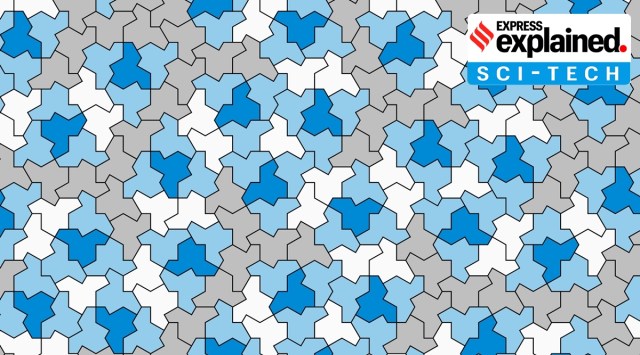Mathematicians discover shape that can perfectly tile a wall without repeating: Explaining geometry’s ‘einstein problem’
The 'einstein tile' – capable of perfectly filling a space without ever repeating – has long been theorised but never discovered before now.
 An einstein tile has long been conjenctured about, but prior to this latest discovery, never found nor proven to exist. (Photo: NYT)
An einstein tile has long been conjenctured about, but prior to this latest discovery, never found nor proven to exist. (Photo: NYT) Mathematicians have discovered a single shape that can be used to cover a surface completely without ever creating a repeating pattern, NYT reported.
Mathematicians have long wondered if there existed an “einstein tile” – a shape that could be singularly used to create a non-repeating (aperiodic) pattern on an infinitely large plane. Here, “einstein” is a play on German ein stein or “one stone” – not to be confused with Albert Einstein, the famous German physicist.
Mathematicians David Smith, Joseph Samuel Myers, Craig S. Kaplan, and Chaim Goodman-Strauss’s new 13-sided shape fits the bill, solving a problem that has stumped scientists for the decades.
Aperiodic tiling
A set of tile-types (or prototiles) is considered to be aperiodic if copies of these tiles can only form patterns without repetition.
In 1961, mathematician Hao Wang conjectured that aperiodic tilings were impossible. But his student, Robert Berger, disputed this, finding a set 104 tiles, which when arranged together will never form a repeating pattern.
In the 1970s, Nobel prize-winning physicist Roger Penrose found a set of only two tiles that could be arranged together in a non-repeating pattern ad infinitum. This is now known as Penrose tiling and has been used in artwork across the world.
Geometry’s einstein problem
But since Penrose’s discovery, mathematicians have been looking for the “holy grail” of aperiodic tiling – a single shape or monotile which can fill a space up to infinity without ever repeating the pattern it creates.
While shapes that can be perfectly fitted on a plane are commonly known – just think of rectangular bathroom tiles or hexagonal tiles which pave footpaths – finding a single shape which can be both perfectly fitting and never repeat the pattern had till now only been theorised about.
Mathematicians call this the einstein problem in geometry. This problem has stumped mathematicians for decades and many felt that there was simply no answer to this problem.
“There are infinitely many possible candidate tiles, and even the existence of a solution feels quite counterintuitive”, University of London mathematician Sarah Hart told The New Scientist.
The discovery
However, the latest discovery, a 13-sided shape which has been named “the hat” by its proponents, has presented a deceptively simple solution.
The hat comprises eight copies of a 60°–90°–120°–90° kite, glued edge-to-edge, and can be generalised to an infinite family of tiles with the same aperiodic property. The shape also retains its aperiodic qualities when varying the lengths of the sides, meaning that the solution is actually a continuum of similar shapes.
The shape was first discovered by David Smith, an amateur mathematician from England. When asked how he discovered this tile, Smith told NYT, “I’m always messing about and experimenting with shapes”.
Smith then worked closely with two computer scientists and another mathematician to develop two proofs showing that “the hat” is indeed an aperiodic monotile – an einstein.
Goodman-Strauss, one of the four credited for the discovery, told The New Scientist that both finding and proving the tile to be aperiodic involved the use of powerful computers and human ingenuity.
“You’re literally looking for like a one in a million thing. You filter out the 999,999 of the boring ones, then you’ve got something that’s weird, and then that’s worth further exploration,” he said. “And then by hand you start examining them and try to understand them, and start to pull out the structure. That’s where a computer would be worthless as a human had to be involved in constructing a proof that a human could understand.”
Applications and implications
While such a discovery might seem to be little more than an interesting curiosity for mathematicians, there are potentially many applications for this discovery.
First, aperiodic tiling will help physicists and chemists understand the structure and behaviour of quasicrystals, structures in which the atoms are ordered but do not have a repeating pattern.
Second, the newly discovered tile might be a springboard for innovative art. “You’re going to see people putting these in a bathroom because it’s just cool,” Colin Adams, Professor of Mathematics at Williams College, Massachusetts.
He added, “I would put it in my bathroom if I were tiling it right now.”
- 01
- 02
- 03
- 04
- 05






































